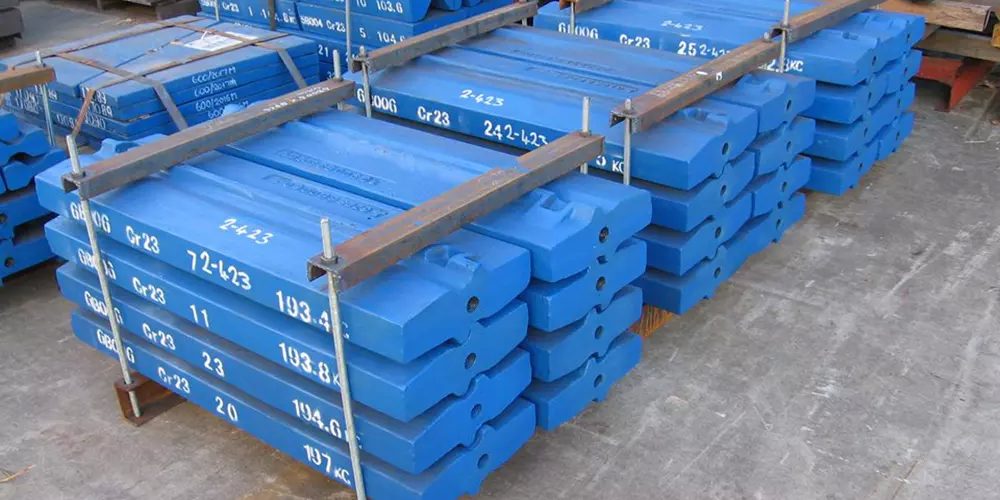There are many kinds of material to cast crusher blow bars. Different working situations need different material blow bars. Based on rich experience, MGS Casting helps you to analysis the different materials for crusher blow bars.
Manganese Steel
This is mainly manganese steel. This alloy is used in primary crushers or crushers that have tramp iron in the feed. Manganese steels will be used whenever very high shock resistance or some elongation is needed. The blow bar life is not easily predictable and depends on many factors. Manganese crusher blow bars are commonly used primary crusher applications and provide high shock resistance and are available in both Mn14% and Mn18% material grades. They are well suited to applications where tramp iron is possible in the feed material. Manganese bars are often used as a ‘safe’ choice, however, other materials available can offer significant life costs benefits. For identification purposes, manganese steel blow bars are painted black or red and marked with the respective material grade. Also, ask about our special high-performance material that is proven to outperform other grades of manganese blow bars.
Martensitic Steel
Martensitic steel will be used whenever hardness and impact resistance are both needed, i.e. in all the applications where usage of white (chromium) irons can lead to breakage. Generally, martensitic steel has a higher lifetime than Mn steels in more abrasive applications when the feed size is below 900mm. It is used in primary and recycling applications. Martensitic steel blow bars are commonly used where the application requires the impact resistance manganese provides and the hardness and wear resistance of chrome irons. Commonly used in both quarrying and recycling, martensitic would normally be expected to outperform manganese steel in abrasive applications.
Chromium Steel
White irons are used when the shock level is rather low and the castings rather thick. Feed to the crusher must be well prepared as far as top size and must be free of tramp iron. Because of the brittle nature of this alloy, tramp iron will cause catastrophic failure of the blow bars. This material is used in secondary, tertiary and asphalt recycle applications where there is no tramp iron. Cast white chromium iron is widely used in ‘classic’ horizontal impact crushers and is available in medium 20% and high 26% chromium content materials. White irons can provide high performance in the right application providing NO tramp iron is present in the feed material. The brittle nature of chrome irons means significant damage can occur if tramp iron or large oversize material is fed into the crusher.
Chromium Steel+Ceramic
This is a composition blow bar consisting of hard ceramic particles on the wear surface in a chromium iron matrix. This composite has the effect of combining the very hard surface of ceramic with the useful mechanical properties of chromium iron. These (chromium/ceramic) blow bars can have two to four times the life of standard mono-alloy blow bars. Chrome Iron with ceramic is a premium composite metallic matrix iron with hard ceramic alloy inserts on the wear surface. The hard alloy ceramics combined with either medium chrome or high chrome iron matrix provides a significant working life advantage over standard chrome iron bars. Whilst this material can be very successful in secondary applications, it should not be used for primary crushing or very hard and abrasive applications.
Martensitic Alloy Steel + Ceramic
Martensitic alloy steel with ceramic is a premium composite metallic matrix steel with hard ceramic alloy inserts on the wear surface. The hard alloy ceramics combined with either martensitic steel matrix provides a significant working life advantage over standard martensitic steel bars. This material is commonly used in recycling industries and primary crushing in quarries. Certain applications are unsuitable for this material, including limestone crushing and slag recycling. This blow bar consisting of hard ceramic particles on the wear surface in a new martensitic steel matrix. Ceramic inlay is deeper and wider than standard Xwin and will provide higher lifetime. These are high-performance blow bars for recycling applications.
Chromium Steel + Titanium Carbide Bars
MGS Casting has succeeded to develop a new material for crusher blow bars users. Titanium carbide bars insert the working face of blow bars to expand the blow bars span life. Compare with normal chromium steel or martensitic steel, its span life can more than 3-5 times. However, the price for TIC insert blow bars just a little expensive than others, so it is the most competitive material for crusher blow bars.







